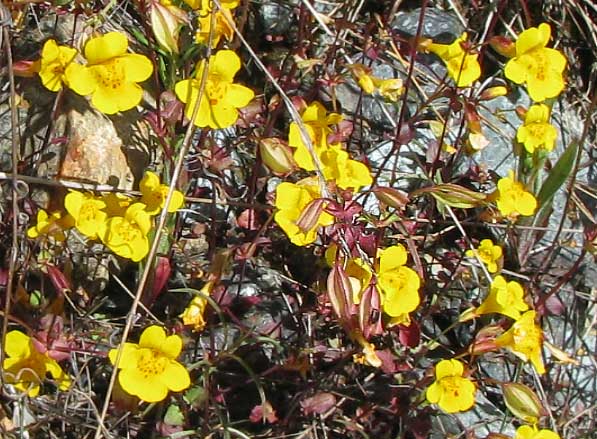
Excerpts from Jim Conrad's
Naturalist Newsletter
from the August 28, 2005 Newsletter issued from the Sierra Nevada foothills
somewhat east of Placerville, California, USA
MONKEYFLOWERS

If California is relatively weak in goldenrods, it is relatively rich in monkeyflowers. Monkeyflowers are members of the genus MIMULUS. In Mississippi we had only two monkeyflower species, the common one, growing throughout the East, being the Winged Monkeyflower, MIMULUS ALATUS, which you can see at https://en.wikipedia.org/wiki/Mimulus_alatus.
Well, for California the Jepson Manual lists about 64 species of monkeyflower!
Most monkeyflower plants bear rather pretty blossoms, sometimes simply bodacious ones. This week in the mountains along a stream in a deep valley with gigantic Douglas-firs all around I came upon a cluster of wildflowers with large, bright-red blossoms and I wasn't at all surprised to see that they were monkeyflowers.
Monkeyflower plants are distinguished by bearing opposite leaves and flower calices that are tubular and 5-angled or 5-winged (clearly visible at the above link). The snapdragonlike blossoms present bilateral symmetry, not radial, four stamens, and a capsular fruit. Some species are woody and some are herbaceous, and blossoms come in every bright color.
On my hikes one of the most commonly seen species, especially along streams, has been the Scarlet Monkeyflower, MIMULUS CARDINALIS, on display at https://calscape.org/Mimulus-cardinalis-(Scarlet-Monkeyflower).
Also along streams and often forming large carpets around cool seeps, has been the Yellow Monkeyflower, MIMULUS GUTTATUS, featured at the top of this page.
Common in dry, disturbed places has been the Torrey's Monkeyflower, MIMULUS TORREYI, to be seen at https://www.calflora.org/app/taxon?crn=5562.